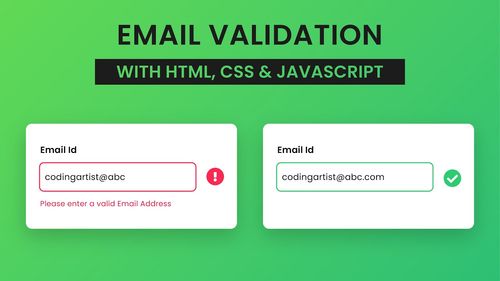In the ever-evolving landscape of web development, mastering email validation is a crucial skill for ensuring data accuracy, enhancing user experience, and safeguarding your applications against faulty inputs. Email addresses serve as the gateway to communication and user identification, making their validation a paramount concern. In this comprehensive guide, I, an expert in JavaScript email validation with regex, will equip you with the knowledge and techniques to validate email addresses flawlessly.
The Significance of Email Validation with Regex in JavaScript
Why is email validation with regex in JavaScript so crucial in modern web development? Email addresses are a fundamental component of user registration, contact forms, and authentication systems. Ensuring that the email addresses you collect are valid not only improves data quality but also enhances the user experience by providing immediate feedback when errors occur.
Basic Email Validation with Regex
Let's start our journey with the fundamentals of email validation using regular expressions (regex) in JavaScript. Regex provides a powerful and flexible way to define patterns for validating email addresses.
Here's a simple example of using regex to validate an email address:
function validateEmail(email) {
const regex = /^[a-zA-Z0-9._-]+@[a-zA-Z0-9.-]+\.[a-zA-Z]{2,4}$/;
return regex.test(email);
}
In this example, we use a regex pattern that checks if an email address follows the common "[email protected]" format. The test method is used to check if the email matches the pattern. While this approach is functional, it's essential to explore more advanced techniques for comprehensive validation.
Advanced Email Validation Techniques with Regex
While the basic regex pattern is a great starting point, there are advanced techniques and scenarios you may encounter when validating email addresses. Let's delve into some of these advanced techniques and how to implement them effectively.
1. Real-Time Validation
Real-time email validation provides immediate feedback to users as they type their email address. Implementing this feature in your web forms enhances the user experience by catching errors as they occur, reducing frustration, and improving data accuracy.
2. Custom Error Messages
Customizing error messages is crucial for providing clear and user-friendly feedback. You can modify the error messages displayed to users based on the validation result. This personalizes the user experience and makes error messages more informative.
3. Server-Side Validation
While client-side validation is essential for immediate feedback, server-side validation is a critical security measure. Always perform server-side validation to ensure the integrity of data submitted to your server and protect against malicious inputs.
4. Multiple Email Validation Rules
You can apply multiple validation rules to a single email address field. For instance, you might want to enforce a specific domain for email addresses or check for unique email addresses in your database.
5. Displaying Validation Errors
The way you display validation errors to users can significantly impact their experience. You can use tooltips, error messages, or visual cues like color changes to indicate whether an email address is valid or not.
Common Questions about Email Validation with Regex in JavaScript
Now that we've explored the fundamentals and advanced techniques of email validation with regex in JavaScript, let's address some common questions that developers often have on this topic.
1. Can regex validate all email addresses accurately?
Regex can validate most common email address formats accurately, but it may not cover all edge cases. Email address validation is a complex task, and regex is just one tool in the validation toolbox.
2. How can I implement real-time email validation in my web form?
To implement real-time email validation, you can use JavaScript event listeners to track changes in the email input field and validate the input dynamically. This provides immediate feedback to users.
3. Are there any security concerns with client-side email validation?
Client-side email validation primarily enhances user experience and data quality. However, it should never be relied upon for security purposes. Always perform server-side validation to ensure data integrity and security.
4. What are the most common regex patterns for email validation?
There are several common regex patterns for email validation, but choosing the right one depends on your specific requirements. Patterns can vary in complexity, and you should select one that fits your validation needs.
Conclusion
Email validation with regex in JavaScript is a valuable skill for any web developer. It ensures data accuracy, enhances user experience, and contributes to the overall security of your applications.
In this comprehensive guide, we've covered the basics of email validation, explored advanced techniques, and addressed common questions. With this knowledge, you are well-prepared to create web forms that collect accurate email data, improve user satisfaction, and meet the demands of modern web development.
So, embrace the power of regex in JavaScript for email validation and watch as your web forms become more robust and user-friendly. Happy coding!



